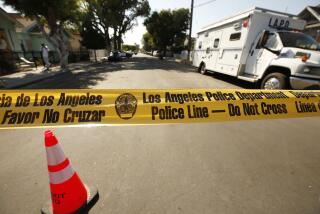Good Day for Bomb Squad Is Often Nerve Shattering
- Share via
It was a training day, so the three full-time members of the Orange County Sheriff Department’s Hazardous Devices Team were viewing news films of a bomb explosion Aug. 16 in front of a Massachusetts building that housed the American-Arab Anti-Discrimination Committee headquarters. The blast seriously injured a Boston police officer.
Just minutes after the team finished discussing how they would handle that situation here, an explosion ripped through an office at 1905 East 17th St., Santa Ana.
When they arrived there, squad leader Charlie Stumph asked an officer if he knew who was the bomb’s target.
“The guy said it was the American-Arab Anti-Discrimination Committee office,” Stumph said.
The sheriff’s bomb squad received nationwide attention following last Friday morning’s blast that ripped a large section of the three-story office building and killed Alex M. Odeh, 41, the committee’s West Coast regional director. But that call was only one of more than 500 the team has received so far this year. Most did not involve life-threatening situations, but squad members are accustomed to living on the edge.
There was the time in January, 1983, for instance, when nine sophisticated pipe bombs were planted in an Armenian-owned bakery in Anaheim. Stumph and squad members Debra Murray, Leon Bennigsdorf and Bill Denton spent 16 agonizing hours defusing three of the devices and removing and carting away the other six.
“When we got done with that thing and came back, everybody sits down and you can’t believe how drained you are,” Stumph said. “Everything’s just drained out of you. You feel like a zombie. I think I can speak for the others when I say all you think is, ‘I sure am glad to be alive.’ ”
Although remote control robots, X-ray devices, armor suits and other gadgets have made defusing and removing bombs much safer, the danger remains.
The ability to remain calm under pressure is a big part of the job. Stumph maintains that the one quality he looks for in a potential squad member is the ability to work as a team.
“You don’t want the individuals,” he said. “You get somebody who wants to do it by themselves and you’re looking at a dead bomb technician.”
The fact that Stumph, 41, still has all his bodily parts bears testimony to his ability. He joined the unit when it was created 15 years ago, and his superiors say his expertise is constantly tapped by bomb technicians throughout the country.
Work Is Less Routine
“Charlie is so cool,” said Sheriff’s Lt. Dick Olson, “that if you pour a gallon of gasoline on his feet and light a match, he’ll just look down at it and say, ‘Well, here’s what we’re gonna do.’ ”
Stumph and the other two full-time members of the squad, Murray, 32, and Bennigsdorf, 31, pretty much agree that they were attracted to the Hazardous Devices Squad because the work is less routine than most law enforcement jobs.
“It provides you with a certain expertise, something you can build on,” said Bennigsdorf, who like Murray joined the squad about four years ago.
The work also involves aspects of law enforcement such as evidence gathering, providing expert testimony at criminal trials and reconstructing explosive devices, such as that used in the bombing in Santa Ana.
About 70% of the squad’s calls involve bomb threats, dangerous chemicals, fireworks and explosive devices such as pipe bombs that are found at freeways, parks, homes, garages and most anywhere. They often are called to dispose of unstable chemicals in school and medical laboratories and to deal with discarded military explosives.
About 65 times a year the squad is called to handle a potentially explosive device that, because of its location, must be dismantled at the scene, as was the case at the Armenian bakery.
$21,000 Robot
The squad’s $21,000 remote-controlled robot, purchased just before the 1984 Olympic Games, enables the unit to handle some devices from a distance. Equipped with a television monitor, claws, a shotgun, wheels that enable it to climb stairs and a 300-foot extension cord, the robot has been called into action 10 times.
The squad took the robot when it made the run to the headquarters of the American-Arab Anti-Defamation Committee headquarters in Santa Ana last Friday morning, but it was not needed.
The call came at about 10:15 a.m., about an hour after the explosion tore through the second floor of the three-story building. By the time the squad got there, the building and two adjacent structures had been evacuated.
“I can’t give the Santa Ana Police and Fire departments enough praise,” Stumph said. “They evacuated the place immediately. There was nobody wandering around.”
Told by one of the officers that there was a suspicious package on the third floor hallway, two part-time bomb technicians, Chris Weare and Steve Garrison, put on 50-pound armor suits and went inside the building. The package was checked and X-rayed and found to be harmless, Stumph said.
Sensitive Investigation
For two days, the squad joined specialists from other local and federal agencies taking evidence from the damaged building. Because of the sensitive nature of the investigation, details of what was found are being withheld.
Investigators will only say that the device was rigged to explode when the door was opened.
The device shattered into minute particles, but Santa Ana Police Sgt. John McClain said specialists will be able to reconstruct it within two weeks.
“We’ll be able to tell you how big it was, what kind of powder was used, where it was placed, everything,” Stumph said.
More to Read
Sign up for Essential California
The most important California stories and recommendations in your inbox every morning.
You may occasionally receive promotional content from the Los Angeles Times.










